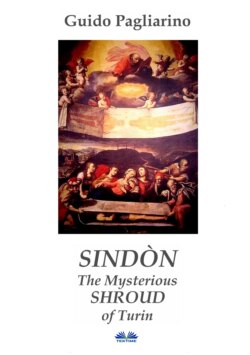Читать книгу Sindòn The Mysterious Shroud Of Turin - Guido Pagliarino - Страница 18
ОглавлениеA mandylion, a cloth with the face of Jesus, was exhibited in Edessa, today Şanliurfa (Urfa) in south-eastern Turkey, in A.D. 544. It has been speculated that it was the Shroud folded in overlapping layers in order to show only the Face, or little more. Is it the Shroud of Turin? In certain images representing the mandylion (Spas Neredica near to Novgorod in Russia, Gradac in Serbia, Laon Aisne in France), it appears as a rectangular lozenge reliquary with a bearded and long hair face in the middle. In 1984, the sindonologist J. P. Jackson detected some uninterrupted marks throughout the Cloth of Turin, corresponding to a folding into eight rectangular parts measuring 110 x 55 cm each: with the Shroud folded in that way, its Face would have appeared on the top, roughly in the middle of the frame, with the torso and a small part of the chest under it20 . It is perfectly plausible that for decency reasons, because of the scandal to show the naked and tortured body of Christ according to the mentality of that times, in Edessa decided to exhibit only the Face of the relic, assuming it was the Shroud. On the other hand, for the same reason the paintings and mosaics did not depict Jesus without clothes at that time, and there were no images of Jesus crucified, or at least wearing a loincloth: they will be produced centuries later.
There is an ancient legend about the origin of the Edessa's image:
The mandylion was an image miraculously produced by Jesus as a gift to Abgar V, known as Ukama (“the Black”), King of Edessa from A.D. 13 to 50. Since he was suffering from leprosy, he sent messengers to Jerusalem during the Easter week for inviting the Nazarene to his court to be cured. Christ, who could not go due to the imminent crucifixion, healed King Abgar through the view of an icon, which delegates carried to the king. According to another version, the mandylion was a portrait painted in tempera by a man called Anania, who was sent to Jesus by Abgar V. Another legend says that Jesus, who was not satisfied with the Anania's work, dipped his fingers into the colors to modify the icon and make it identical to his face. However, Abgar V healed when he saw the image; and therefore he converted to Christianity, along with his son Ma’nu V (who was king for a short time after his father died). But Abgar's nephew Ma’nu VI, who took the throne in A.D. 57, reverted to paganism and started to persecute Christians. Even today, an icon painted in tempera with an egg-white base, which would be the one sent by Jesus to King Abgar, is venerated at the Genoese church of San Bartolomeo degli Armeni. Obviously, the Shroud is not a painting, and therefore the mandylion is not the Shroud. The one showed in Genoa is rather an ancient Byzantine icon inspired by the mandylion and probably produced in Edessa.
